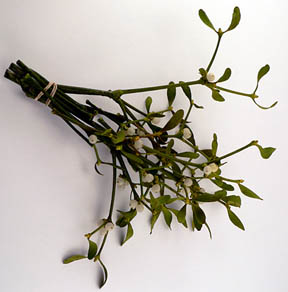Mistletoe Roots Not So Romantic
Mistletoe Roots Not So Romantic


Mistletoe usually triggers innocent kisses underneath the plant in late December. However, mistletoe is not as innocent as it appears. The plant is a pest that grows on twigs and branches on Kentucky trees, extracting water, minerals and food from its host.
“Mistletoes are highly visible on large trees throughout Kentucky, especially in winter when trees have lost their leaves,” said John Hartman, University of Kentucky College of Agriculture plant pathologist. “The tree branch is often swollen at the point of mistletoe attachment.”
Leafy mistletoes are most often associated with hardwoods in the southern two-thirds of the United States. Cold weather limits the pest in the northern part of the country. Hartman said mistletoe seeds are spread by berry-eating birds, so even when harvested the pest comes back in a few years. He also said mistletoes can be harmful to trees in times of stress, mostly in urban environments.
Furthermore, Hartman explained that mistletoe has not always been associated with the Christmas holiday season.
“Mistletoe takes its name from the old Saxon ‘mistl-tan,’ which means a different twig,” Hartman explained. “It refers to the fact that it is growing on a tree, whose twigs it does not resemble. It actually has distinctly pagan roots.”
Hartman said pagans believed that because the plant appeared to be alive in winter while the host tree appears dead, it held the life of the tree during the winter. Druids believed it represented the spirit of the tree because it “grew in the air on the sacred oak.”
“They harvested it with a golden sickle in a ceremonial ritual,” Hartman said. “Ensuring that the mistletoe never touched the ground, it was distributed among them and hung in their homes, where it was supposed to bring them good luck.”
Some people in Celtic and Scandinavian countries still ceremonially pluck mistletoe from trees on the eves of the summer and winter solstices.
So why do people feel the urge to kiss underneath such a notorious piece of evergreen during the holidays?
Hartman said part of mistletoe’s reputation can be attributed to Norse mythology where Frigga, the goddess of love and beauty is said to bestow a kiss on anyone walking beneath the plant, in gratitude for the mistletoe-mediated restoration of her son from possible death.
“The older tradition required a male to kiss a female under the mistletoe, and when the berries were gone the plant was supposed to lose its efficacy and no more kisses could be required,” Hartman added.
Other mistletoe beliefs and traditions include placing branches of the plant over house and stable doors in Europe to keep out witches; giving the Christmas bunch of mistletoe to the first cow that gave birth in the new year to bring luck to the entire herd; using it as a plant of peace in Scandinavia, under which enemies could declare a truce or spouses could “kiss and make up.” In some parts of England, Christmas mistletoe is burned on the 12th night so that all the boys and girls who kissed under it would be spared the curse not to marry.
Hartman said mistletoe can be controlled on landscape trees by pruning, if necessary.
